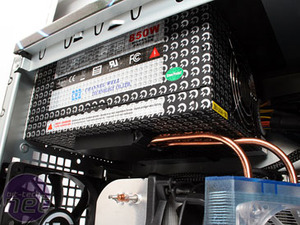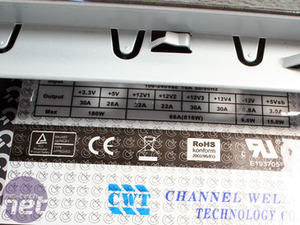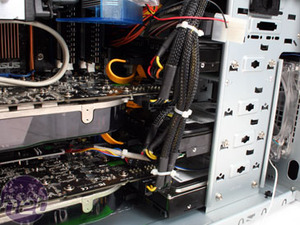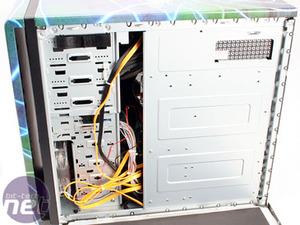
Hardware Included
- Intel Core 2 Extreme QX6800 quad-core processor (2.93GHz)
- 2GB Corsair Dominator PC2-8500 (clocked at 800MHz 5-5-5-18-2T)
- Asus P5N32E-SLI (nForce 680i SLI)
- Two GeForce 8800 GTXs in SLI (the latest XX machines come with two 8800 Ultras)
- Creative X-Fi XtremeGamer
- Samsung WriteMaster SATA DVD-RW
- Two 150GB Western Digital Raptor ADAF hard drives
- One 500GB Samsung HD501LJ hard drive
- Card Reader
Despite all this extra cooling the PSU still spins the fans up very fast when you load the machine, but it's hardly surprising considering the rest of the hardware inside is largely power guzzling, and you'll likely be playing games with plenty of noise from your speakers or headphones anyway. The fans remain on after PC is turned off to keep cooling the unit down; unfortunately, the system fans don't stay on as well, which is a shame but is understandably far harder to engineer.
The two Western Digital Raptors in RAID 0 deliver great performance but increase the chance of failure, because the data is split over two hard drives instead of one, without redundancy. There is no option on site for RAID 5, which the nForce 680i chipset can do. Commodore does give you the option to select to have your OS on a single drive instead and that's something we'd recommend for a whole load of reasons. Raptors aren't the quietest drives on earth and the noise deadening will go some way to keeping them quiet. We couldn't specifically hear them running when the PC was on, and the XX model seems to be inherently made for performance not silence.
500GB is the largest (or indeed, smallest) secondary drive you can select, no option is given for cheaper 250/320GB drives or even the expansive 750GB or Terabyte hard drives now available. Commodore does use a quiet Samsung drive for the 500GB option, and this should really be plenty of storage space for most people, but without eSATA and easy internal expansion capabilities, your options for the future are limited.
The Asus P5N32-E motherboard is a good choice for solid performance, but it's about £20 more expensive than the "Plus" model we looked at earlier this year, which features the 650i northbridge. The Asus option is still cheaper than any other Nvidia nForce 680i SLI motherboard though, and advertising the fact that there is a "full Nvidia nForce 680i SLI" capable motherboard inside is certainly a market draw. In addition it looks better than any alternative Nvidia nForce 680i LT SLI motherboard, but like everything else inside, you're not going to see it anyway.
What gets us is, why plump for the more expensive motherboard when it don't use the additional features like EPP? Our board came with EPP disabled, despite it having compatible Corsair Dominator memory. Not only that, it's Corsair Dominator 8500 rated at 1066MHz with 5-5-5-15 timings, but by default is only being used at 800MHz 5-5-5-18-2T! Talk about over expense for under use.
You could argue that there are limited options on the website: 2GB or 4GB Corsair, but that's really all that people need unless you specifically prefer other brands. Trying to install more memory is incredibly difficult however, because of the heatpipe, heatsinks and blue shroud you can't take off the PSU, this means you have to carefully and awkwardly manoeuvre the memory beneath, around and behind everything that's obstructing the direct path.
If you're a fan of ATI CrossFire you're out of luck. The DFI ICFX3200T2R/G would have been a good alternative here, considering there are still no P35 ATI CrossFire drivers, but unfortunately it looks like Commodore has put its ball firmly inside Nvidia's court for the foreseeable future.
No gaming PC is complete without a gaming soundcard and Commodore uses the Creative X-Fi XtremeGamer we reviewed a couple of weeks ago. There is literally no other soundcard choice for a gaming PC other than something else made by Creative, still, but not even offering the option of an X-Fi Fatal1ty version with X-RAM and 5.25" bay module is a little crazy for a top of the line PC. Or perhaps you want to use separate audio gear, so something like the M-Audio card or even Asus Xonar D2 might be an appropriate alternative.
Having a "none" option for monitors, keyboard and mice is certainly a winner in our books, at least this leaves you free to use old peripherals or search for what exactly fits your needs. However, what is on offer is certainly not that bad as far as the G3/G5 mice go (we would like to see some Razor mice as well, perhaps), and the G11 and G15 gaming keyboards are both good choices too. With regards to monitors it's not quite as rosy, as the maximum screen size is 22". They screens available may be Samsung screens but a couple of 8800 GTXs or Ultras can easily handle 24" or 30" of visual real estate. Plus, if you're going to drop nearly £3,000 on a top notch system you'll want something to complement what's inside.
We quizzed Commodore about the lack of variety and a representative told us this: "Agreed, but in the start-up phase we had to limit our product offering to ensure speedy delivery and quality products. We will be adding bigger screens in the near future (Samsung SyncMaster 305T for example)."
The same was said for soundcards too, so expect there to be more variety as the brand matures.

MSI MPG Velox 100R Chassis Review
October 14 2021 | 15:04














Want to comment? Please log in.